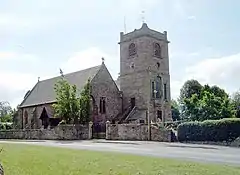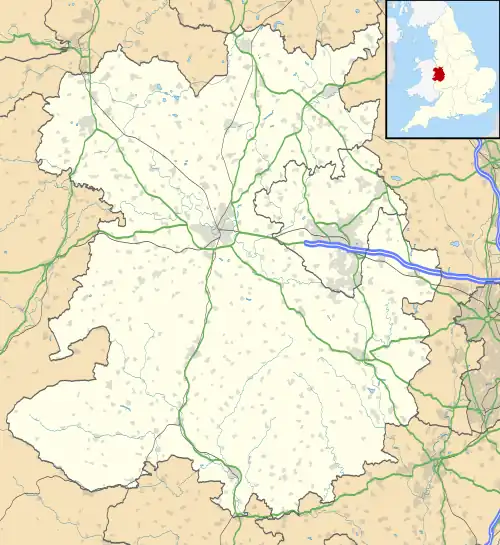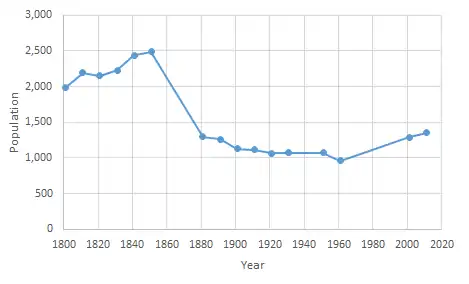Westbury, Shropshire
Westbury is a village and parish in Shropshire, England. It includes the settlements of Caus Forest, Lake, Marche, Newtown, Stoney Stretton, Vennington, Wallop, Westbury, Whitton, Winsley and Yockleton. It lies 8 miles (13 km) west of Shrewsbury, close to the Wales-England border. It is located at 135 m altitude. It had a population of 1,352 according to the 2011 census.[2] In 2005, Westbury parish expanded with the annexation of half of the former Wollaston parish.
| Westbury | |
|---|---|
 St Mary's church in Westbury. | |
 Westbury Location within Shropshire | |
| Area | 15 sq mi (39 km2) [1] |
| Population | 1,352 [2] |
| • Density | 90/sq mi (35/km2) |
| OS grid reference | SJ355094 |
| Civil parish |
|
| Unitary authority | |
| Ceremonial county | |
| Region | |
| Country | England |
| Sovereign state | United Kingdom |
| Post town | SHREWSBURY |
| Postcode district | SY5 |
| Dialling code | 01743 |
| Police | West Mercia |
| Fire | Shropshire |
| Ambulance | West Midlands |
| UK Parliament | |
It is situated on the B4386 road which travels from Shrewsbury to Montgomery. Amenities include a Marstons Pub called 'The Lion', a medical practice surgery, and a cemetery on Hinwood Road. The primary school (St Mary's CE Aided) closed in 2017, merging in a federation with Worthen and Hope into the Long Mountain School at Worthen.
History
Roman
During the Roman settlement of Britain it was an outpost of Wroxeter. The present Shrewsbury to Westbury road is thought to follow the alignment of a Roman road from Wroxeter to forts at Forden Gaer and Caersws. In about 1848, a piece of lead was found with markings of the name of the Roman Emperor Aurelian.[3]
Middle Ages
During the early Middle Ages the Rea Valley was of strategic importance in the defence of the Welsh Marches west of Shrewsbury as the main route from Montgomery to Shrewsbury came through the village. Frontier guards are said to have been killed at Westbury in 1053 when Ernui held the manor. About one mile (1.6 km) from Westbury lie the scant ruins of Caus Castle. Built in the late 11th century originally it was used as a border stronghold.[3] Westbury’s strategic importance was diminished after the Norman Conquest when Montgomery Castle was built.
Domesday
Westbury is recorded in the Domesday Book as the property of Roger Fitz Corbet who held it on behalf of the Earl of Shrewsbury, Roger de Montgomery. Two priests were also recorded as incumbents at Westbury church. After the lapse of the suzerainty of the Earls of Shrewsbury in 1102, the manor was held by the barony of Caus until the end of feudal tenures.
18th and 19th centuries
The road to Asterley originated as a field road to the Common Wood of Hinwood, but became of some importance in the 18th century when used by coal wagons from the Asterley Mines. In the Middle Ages the road which passes through Vennington and along the crest of the Long Mountain was the principal route between Shrewsbury and Newtown, and was still used as an alternative route to Welshpool up to the 1820s.
In 1870–72, Westbury was described by John Marius Wilson's Imperial Gazetteer of England and Wales like this:
- "WESTBURY, a township and a parish in Atcham district, Salop. The township lies on the Shrewsbury and Welshpool railway, 11½ miles W by S of Shrewsbury; contains a village of its own name; and has a post-office under Shrewsbury, and a r[ailway]. station. Real property, £6,174; of which £200 are in mines. Pop[ulation]. in 1851, 1,497; in 1861, 1,655. Houses, 298. The property is not much divided. The parish includes Minsterley chapelry, and forms a sub-district. Acres, 11,274. Rated property in 1869, £16,158. Pop., 2,545. Houses, 476. The living is a rectory in the diocese of Hereford. Value, £766. Patron, R. Cholmondeley, Esq. The church is good. The p[erpetual]. curacy of Minsterley is a separate benefice. There are dissenting chapels, an endowed school with £30 a year, and charities £44."[4]


In 1831 the dominating occupation was working in agriculture and farming.[5] There were no manufacturing jobs in 1831.[5] In 2001 there were 80, which decreased to 52 in 2011.[6][7] Several coal and lead mines were being worked near Shrewsbury and Westbury at the former time. Many collieries were closed by 1921, with the last closing in 1941.[8]

Railways
Previously served by Westbury station on the Cambrian Line. The station closed in 1960.[9]
Notable people
- Henry Stafford, 1st Baron Stafford (1501-1563), died at Caus Castle in the parish.[10]
- Sir Thomas Higgons (c1624-1691), politician and diplomat, was son of a Rector of Westbury.
- Elhanan Bicknell (1788-1861), London art collector, lived at Caus in the parish for a year to learn farming.
- William Cureton (1808-1864), Orientalist, was born at Westbury.
- John Edmund Severne (1826-1899), Conservative politician, lived at Wallop Hall in Westbury parish, buried in Westbury Churchyard.
- John Doogan (1853-1940), Victoria Cross recipient, was living at Cause Mountain in Westbury parish in 1911.[11]
- Sir Smith Child, 2nd Baronet (1880-1958), Conservative politician and former army officer, lived at Whitton Hall[12] in the parish and is buried in Westbury Churchyard.
References
- "Westbury (Parish): Population Density, 2011". Neighbourhood Statistics. Office for National Statistics. Retrieved 28 April 2014.
- "Westbury (Parish): Key Figures for 2011 Census: Key Statistics". Neighbourhood Statistics. Office for National Statistics. Retrieved 28 April 2014.
- Hinson, Colin. "The National Gazetteer of Great Britain and Ireland". GENUKI. Retrieved 28 April 2014.
- Wilson, John Marius (1870–72). Imperial Gazetteer of England and Wales. Westbury: A. Fullarton & Co. Retrieved 28 April 2014.
- GB Historical GIS / University of Portsmouth, A Vision of Britain through Time. "Westbury CP/AP through time. Males aged 20 & over, in 9 occupational categories in 1831". Industry Statistics. Retrieved 28 April 2014.
- "Westbury (Parish): Industry of Employment 2001". Neighbourhood Statistics. Office for National Statistics. Retrieved 28 April 2014.
- "Westbury (Parish): Industry, 2011". Neighbourhood Statistics. Office for National Statistics. Retrieved 28 April 2014.
- Shropshire Mines. "Shrewsbury Coalfield". Retrieved 28 April 2014.
- "Stations". Shropshire History. Retrieved 19 March 2017.
- Henry Stafford, 1st Baron Stafford profile, Oxford Dictionary of National Biography. Retrieved 17 January 2010.
- 1911 Census of England and Wales, form at National Archives AncestryLibrary.com.
- Kelly's Handbook to the Titled, Landed and Official Classes, 1948. Kelly's. p. 458.Earliest mention of Whitton Hall as home.